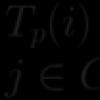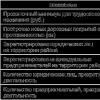How to plot arcsin. Arcsine, arccosine - properties, graphs, formulas. Getting the arcsin function
(circular functions, arc functions) - mathematical functions that are inverse to trigonometric functions.
Arc cosine, inverse function to cos (x = cos y), y = arccos x is defined for and has a set of values . In other words, returns the angle by its value cos.
Arc cosine(symbol: arccos x; arccos x is the angle whose cosine is equal to x etc).
Function y = cos x continuous and bounded along its entire number line. Function y = arccos x is strictly decreasing.

Properties of the arcsin function.
Getting the arccos function.
Given a function y = cos x. It is piecewise monotonic over its entire domain of definition, and hence the inverse correspondence y = arccos x is not a function. Therefore, we will consider the segment on which it strictly decreases and takes on all its values - . On this segment y = cos x decreases strictly monotonically and takes all its values only once, which means that there is an inverse function on the interval y = arccos x, whose graph is symmetrical to the graph y = cos x on a line segment y=x.
Definition and notation
Arcsine (y = arcsin x) is the inverse function of the sine (x = siny -1 ≤ x ≤ 1 and the set of values -π /2 ≤ y ≤ π/2.sin(arcsin x) = x ;
arcsin(sin x) = x .
The arcsine is sometimes referred to as:
.
Graph of the arcsine function
Graph of the function y = arcsin x
The arcsine plot is obtained from the sine plot by interchanging the abscissa and ordinate axes. To eliminate the ambiguity, the range of values is limited to the interval on which the function is monotonic. This definition is called the main value of the arcsine.
Arccosine, arccos
Definition and notation
Arc cosine (y = arccos x) is the inverse of the cosine (x = cos y). It has scope -1 ≤ x ≤ 1 and many values 0 ≤ y ≤ π.cos(arccos x) = x ;
arccos(cos x) = x .
The arccosine is sometimes referred to as:
.
Graph of the arccosine function

Graph of the function y = arccos x
The arccosine plot is obtained from the cosine plot by interchanging the abscissa and ordinate axes. To eliminate the ambiguity, the range of values is limited to the interval on which the function is monotonic. This definition is called the main value of the arc cosine.
Parity
The arcsine function is odd:
arcsin(-x) = arcsin(-sin arcsin x) = arcsin(sin(-arcsin x)) = - arcsin x
The arccosine function is not even or odd:
arccos(-x) = arccos(-cos arccos x) = arccos(cos(π-arccos x)) = π - arccos x ≠ ± arccos x
Properties - extrema, increase, decrease
The arcsine and arccosine functions are continuous on their domain of definition (see the proof of continuity). The main properties of the arcsine and arccosine are presented in the table.
| y = arcsin x | y = arccos x | |
| Scope and continuity | - 1 ≤ x ≤ 1 | - 1 ≤ x ≤ 1 |
| Range of values | ||
| Ascending, descending | increases monotonically | decreases monotonically |
| Maximums | ||
| Lows | ||
| Zeros, y= 0 | x= 0 | x= 1 |
| Points of intersection with the y-axis, x = 0 | y = 0 | y = π/ 2 |
Table of arcsines and arccosines
This table shows the values of arcsines and arccosines, in degrees and radians, for some values of the argument.
| x | arcsin x | arccos x | ||
| deg. | glad. | deg. | glad. | |
| - 1 | - 90° | - | 180° | π |
| - | - 60° | - | 150° | |
| - | - 45° | - | 135° | |
| - | - 30° | - | 120° | |
| 0 | 0° | 0 | 90° | |
| 30° | 60° | |||
| 45° | 45° | |||
| 60° | 30° | |||
| 1 | 90° | 0° | 0 | |
≈ 0,7071067811865476
≈ 0,8660254037844386
Formulas
See also: Derivation of formulas for inverse trigonometric functionsSum and difference formulas
at or
at and
at and
at or
at and
at and
at
at
at
at
Expressions in terms of logarithm, complex numbers
See also: Derivation of formulasExpressions in terms of hyperbolic functions
Derivatives
;
.
See Derivation of arcsine and arccosine derivatives > > >
Derivatives of higher orders:
,
where is a polynomial of degree . It is determined by the formulas:
;
;
.
See Derivation of higher order derivatives of arcsine and arccosine > > >
Integrals
We make a substitution x = sin t. We integrate by parts, taking into account that -π/ 2 ≤ t ≤ π/2,
cos t ≥ 0:
.
We express the arccosine in terms of the arcsine:
.
Expansion in series
For |x|< 1
the following decomposition takes place:
;
.
Inverse functions
The inverses of the arcsine and arccosine are sine and cosine, respectively.
The following formulas are valid throughout the domain of definition:
sin(arcsin x) = x
cos(arccos x) = x .
The following formulas are valid only on the set of values of the arcsine and arccosine:
arcsin(sin x) = x at
arccos(cos x) = x at .
References:
I.N. Bronstein, K.A. Semendyaev, Handbook of Mathematics for Engineers and Students of Higher Educational Institutions, Lan, 2009.
Tasks related to inverse trigonometric functions are often offered at school final exams and at entrance exams in some universities. A detailed study of this topic can only be achieved in extracurricular classes or in elective courses. The proposed course is designed to develop the abilities of each student as fully as possible, to improve his mathematical training.
The course is designed for 10 hours:
1. Functions of arcsin x, arccos x, arctg x, arcctg x (4 hours).
2. Operations on inverse trigonometric functions (4 hours).
3. Inverse trigonometric operations on trigonometric functions (2 hours).
Lesson 1 (2 hours) Topic: Functions y = arcsin x, y = arccos x, y = arctg x, y = arcctg x.
Purpose: full coverage of this issue.
1. Function y \u003d arcsin x.
a) For the function y \u003d sin x on the segment, there is an inverse (single-valued) function, which we agreed to call the arcsine and denote as follows: y \u003d arcsin x. The graph of the inverse function is symmetrical with the graph of the main function with respect to the bisector of I - III coordinate angles.
Function properties y = arcsin x .
1)Scope of definition: segment [-1; one];
2) Area of change: cut ;
3) Function y = arcsin x odd: arcsin (-x) = - arcsin x;
4) The function y = arcsin x is monotonically increasing;
5) The graph crosses the Ox, Oy axes at the origin.
Example 1. Find a = arcsin . This example can be formulated in detail as follows: find such an argument a , lying in the range from to , whose sine is equal to .
Solution. There are countless arguments whose sine is , for example: ![]() etc. But we are only interested in the argument that is on the interval . This argument will be . So, .
etc. But we are only interested in the argument that is on the interval . This argument will be . So, .
Example 2. Find  .Solution. Arguing in the same way as in Example 1, we get
.Solution. Arguing in the same way as in Example 1, we get  .
.
b) oral exercises. Find: arcsin 1, arcsin (-1), arcsin , arcsin (), arcsin , arcsin (), arcsin , arcsin (), arcsin 0 Sample answer:  , because
, because ![]()
![]() . Do the expressions make sense: ; arcsin 1.5;
. Do the expressions make sense: ; arcsin 1.5; ![]() ?
?
c) Arrange in ascending order: arcsin, arcsin (-0.3), arcsin 0.9.
II. Functions y = arccos x, y = arctg x, y = arcctg x (similarly).
Lesson 2 (2 hours) Topic: Inverse trigonometric functions, their graphs.
Purpose: in this lesson it is necessary to work out the skills in determining the values trigonometric functions, in plotting inverse trigonometric functions using D (y), E (y) and the necessary transformations.
In this lesson, perform exercises that include finding the domain of definition, the scope of functions of the type: y = arcsin , y = arccos (x-2), y = arctg (tg x), y = arccos .
It is necessary to build graphs of functions: a) y = arcsin 2x; b) y = 2 arcsin 2x; c) y \u003d arcsin;
d) y \u003d arcsin; e) y = arcsin; f) y = arcsin; g) y = | arcsin | .
Example. Let's plot y = arccos
You can include the following exercises in your homework: build graphs of functions: y = arccos , y = 2 arcctg x, y = arccos | x | .
Graphs of inverse functions
Lesson #3 (2 hours) Topic:
Operations on inverse trigonometric functions.Purpose: to expand mathematical knowledge (this is important for applicants to specialties with increased requirements for mathematical preparation) by introducing the basic relationships for inverse trigonometric functions.
Lesson material.
Some simple trigonometric operations on inverse trigonometric functions: sin (arcsin x) \u003d x, i xi? one; cos (arсcos x) = x, i xi? one; tg (arctg x)= x , x I R; ctg (arcctg x) = x , x I R.
Exercises.
a) tg (1.5 + arctg 5) = - ctg (arctg 5) = ![]() .
.
ctg (arctgx) = ; tg (arctg x) = .
b) cos (+ arcsin 0.6) = - cos (arcsin 0.6). Let arcsin 0.6 \u003d a, sin a \u003d 0.6;
cos(arcsin x) = ; sin (arccos x) = .
Note: we take the “+” sign in front of the root because a = arcsin x satisfies .
c) sin (1.5 + arcsin). Answer:;
d) ctg ( + arctg 3). Answer: ;
e) tg (- arcctg 4). Answer: .
f) cos (0.5 + arccos) . Answer: .
Calculate:
a) sin (2 arctan 5) .
Let arctg 5 = a, then sin 2 a = ![]() or sin(2 arctan 5) =
or sin(2 arctan 5) = ![]() ;
;
b) cos (+ 2 arcsin 0.8). Answer: 0.28.
c) arctg + arctg.
Let a = arctg , b = arctg ,
then tan(a + b) =  .
.
d) sin (arcsin + arcsin).
e) Prove that for all x I [-1; 1] true arcsin x + arccos x = .
Proof:
arcsin x = - arccos x
sin (arcsin x) = sin (- arccos x)
x = cos (arccos x)
For a standalone solution: sin (arccos ), cos (arcsin ) , cos (arcsin ()), sin (arctg (- 3)), tg (arccos ) , ctg (arccos ).
For a home solution: 1) sin (arcsin 0.6 + arctg 0); 2) arcsin + arcsin; 3) ctg ( - arccos 0.6); 4) cos (2 arcctg 5) ; 5) sin (1.5 - arcsin 0.8); 6) arctg 0.5 - arctg 3.
Lesson No. 4 (2 hours) Topic: Operations on inverse trigonometric functions.
Purpose: in this lesson to show the use of ratios in the transformation of more complex expressions.
Lesson material.
ORALLY:
a) sin (arccos 0.6), cos (arcsin 0.8);
b) tg (arctg 5), ctg (arctg 5);
c) sin (arctg -3), cos (arctg ());
d) tg (arccos ), ctg (arccos()).
WRITTEN:
1) cos (arcsin + arcsin + arcsin).
2) cos (arctg 5 - arccos 0.8) = cos (arctg 5) cos (arctg 0.8) + sin (arctg 5) sin (arccos 0.8) =
3) tg (- arcsin 0.6) = - tg (arcsin 0.6) = 
4) ![]()
Independent work will help to determine the level of assimilation of the material
| 1) tg ( arctg 2 - arctg ) 2) cos( - arctg2) 3) arcsin + arccos |
1) cos (arcsin + arcsin) 2) sin (1.5 - arctg 3) 3) arcctg3 - arctg 2 |
For homework can offer:
1) ctg (arctg + arctg + arctg); 2) sin 2 (arctg 2 - arcctg ()); 3) sin (2 arctg + tg ( arcsin )); 4) sin (2 arctan); 5) tg ( (arcsin ))
Lesson No. 5 (2h) Topic: Inverse trigonometric operations on trigonometric functions.
Purpose: to form students' understanding of inverse trigonometric operations on trigonometric functions, focus on increasing the meaningfulness of the theory being studied.
When studying this topic, it is assumed that the amount of theoretical material to be memorized is limited.
Material for the lesson:
You can start learning new material by examining the function y = arcsin (sin x) and plotting it.
3. Each x I R is associated with y I , i.e.<= y <= такое, что sin y = sin x.
4. The function is odd: sin (-x) \u003d - sin x; arcsin(sin(-x)) = - arcsin(sin x).
6. Graph y = arcsin (sin x) on:
a) 0<= x <= имеем y = arcsin(sin x) = x, ибо sin y = sin x и <= y <= .
b)<= x <= получим y = arcsin (sin x) = arcsin ( - x) = - x, ибо
sin y \u003d sin ( - x) \u003d sinx, 0<= - x <= .
So, 
Having built y = arcsin (sin x) on , we continue symmetrically about the origin on [- ; 0], taking into account the oddness of this function. Using periodicity, we continue to the entire numerical axis.
Then write down some ratios: arcsin (sin a) = a if<= a <= ; arccos (cos a ) = a if 0<= a <= ; arctg (tg a) = a if< a < ; arcctg (ctg a) = a , если 0 < a < .
And do the following exercises: a) arccos (sin 2). Answer: 2 - ; b) arcsin (cos 0.6). Answer: - 0.1; c) arctg (tg 2). Answer: 2 -;
d) arcctg (tg 0.6). Answer: 0.9; e) arccos (cos ( - 2)). Answer: 2 -; f) arcsin (sin (- 0.6)). Answer: - 0.6; g) arctg (tg 2) = arctg (tg (2 - )). Answer: 2 - ; h) arcctg (tg 0.6). Answer: - 0.6; - arctanx; e) arccos + arccos
The sin, cos, tg, and ctg functions are always accompanied by an arcsine, arccosine, arctangent, and arccotangent. One is a consequence of the other, and pairs of functions are equally important for working with trigonometric expressions.
Consider the drawing of a unit circle, which graphically displays the values of trigonometric functions.
If you calculate arcs OA, arcos OC, arctg DE and arcctg MK, then they will all be equal to the value of the angle α. The formulas below reflect the relationship between the main trigonometric functions and their corresponding arcs.

To understand more about the properties of the arcsine, it is necessary to consider its function. Schedule has the form of an asymmetric curve passing through the center of coordinates.

Arcsine properties:
If we compare graphs sin and arc sin, two trigonometric functions can find common patterns.

Arc cosine
Arccos of the number a is the value of the angle α, the cosine of which is equal to a.
Curve y = arcos x mirrors the plot of arcsin x, with the only difference being that it passes through the point π/2 on the OY axis.

Consider the arccosine function in more detail:
- The function is defined on the segment [-1; one].
- ODZ for arccos - .
- The graph is entirely located in the I and II quarters, and the function itself is neither even nor odd.
- Y = 0 for x = 1.
- The curve decreases along its entire length. Some properties of the arc cosine are the same as the cosine function.
Some properties of the arc cosine are the same as the cosine function.

It is possible that such a “detailed” study of the “arches” will seem superfluous to schoolchildren. However, otherwise, some elementary typical USE tasks can lead students to a dead end.
Exercise 1. Specify the functions shown in the figure.

Answer: rice. 1 - 4, fig. 2 - 1.
In this example, the emphasis is on the little things. Usually, students are very inattentive to the construction of graphs and the appearance of functions. Indeed, why memorize the form of the curve, if it can always be built from calculated points. Do not forget that under test conditions, the time spent on drawing for a simple task will be required to solve more complex tasks.
Arctangent
Arctg the number a is such a value of the angle α that its tangent is equal to a.

If we consider the plot of the arc tangent, we can distinguish the following properties:
- The graph is infinite and defined on the interval (- ∞; + ∞).
- Arctangent is an odd function, therefore, arctan (- x) = - arctan x.
- Y = 0 for x = 0.
- The curve increases over the entire domain of definition.
Let's give a brief comparative analysis of tg x and arctg x in the form of a table.

Arc tangent
Arcctg of the number a - takes such a value of α from the interval (0; π) that its cotangent is equal to a.

Properties of the arc cotangent function:
- The function definition interval is infinity.
- The range of admissible values is the interval (0; π).
- F(x) is neither even nor odd.
- Throughout its length, the graph of the function decreases.
Comparing ctg x and arctg x is very simple, you just need to draw two drawings and describe the behavior of the curves.

Task 2. Correlate the graph and the form of the function.

Logically, the graphs show that both functions are increasing. Therefore, both figures display some arctg function. It is known from the properties of the arc tangent that y=0 for x = 0,
Answer: rice. 1 - 1, fig. 2-4.
Trigonometric identities arcsin, arcos, arctg and arcctg
Previously, we have already identified the relationship between arches and the main functions of trigonometry. This dependence can be expressed by a number of formulas that allow expressing, for example, the sine of an argument through its arcsine, arccosine, or vice versa. Knowledge of such identities can be useful in solving specific examples.

There are also ratios for arctg and arcctg:

Another useful pair of formulas sets the value for the sum of the arcsin and arcos and arcctg and arcctg values of the same angle.

Examples of problem solving
Trigonometry tasks can be conditionally divided into four groups: calculate the numerical value of a particular expression, plot a given function, find its domain of definition or ODZ, and perform analytical transformations to solve the example.
When solving the first type of tasks, it is necessary to adhere to the following action plan:

When working with graphs of functions, the main thing is the knowledge of their properties and the appearance of the curve. Tables of identities are needed to solve trigonometric equations and inequalities. The more formulas the student remembers, the easier it is to find the answer to the task.
Suppose in the exam it is necessary to find the answer for an equation of the type:

If you correctly transform the expression and bring it to the desired form, then solving it is very simple and fast. First, let's move arcsin x to the right side of the equation.

If we remember the formula arcsin (sinα) = α, then we can reduce the search for answers to solving a system of two equations:

The constraint on the model x arose, again from the properties of arcsin: ODZ for x [-1; one]. When a ≠ 0, part of the system is a quadratic equation with roots x1 = 1 and x2 = - 1/a. With a = 0, x will be equal to 1.



















